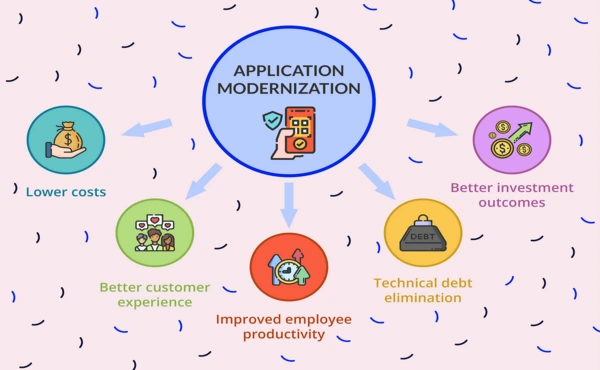Application modernization software works similarly to a toolkit, helping old apps run smoothly on modern platforms. It's important because it helps businesses, especially software development companies, keep software working when technology improves rapidly. This blog will look at how application modernization software works, why it is important, and what benefits it provides to users and businesses alike.
What is Application Modernization?
Application modernization is the process of updating older software applications to make them easier to use with modern devices and systems. Consider how frequently your phone's games or apps require upgrades to function properly or to add new features. Also, companies must keep their software up to date, or it might stop working properly and become a security risk.
Companies use application modernization software to improve the speed, security, and usability of their current apps with new technologies. Without modernization, a previously useful program may become slow, difficult to use, or even unusable on today's devices. Modernization enables businesses to avoid these challenges and keep their programs functioning smoothly.
How Does Application Modernization Software Work?
Application modernization software has many features that help give old applications a "makeover." Here’s a simple look at what it does:
Upgrade Outdated Parts
As software ages, some components may stop working properly on new computers. Application modernization software can detect outdated parts and replace them with newer, faster technologies.
Improves Security
Older software may not have protection against current dangers such as hackers and viruses. Modernization software helps to address these challenges, making apps safer for both businesses and users.
Increases compatibility
New devices and operating systems are always being developed. Application modernization software ensures that existing apps work on new platforms, such as upgraded computers, smartphones, and tablets.
Improves User Experience
An updated app is easier and enjoyable to use. Modernization allows you to add new features, improve the app's layout, and make everything run more smoothly.
These capabilities enable businesses to keep existing software useful for a long time, reducing the need to design new software from start. Instead, businesses may maintain their existing apps fresh and useful by using application modernization tools.
Types of Application Modernization Software
Application modernization software comes in different types, depending on how much change is needed. Here are three common methods:
Rehosting
This strategy involves moving an app from its previous system to a newer one without modifying the app. It's like shifting a toy from one room to another without breaking it. Rehosting is quick and simple, but it may not improve the app's performance.
Replatforming
With replatforming, the app undergoes minor changes to improve its performance on a new system. It's like giving your toy a minor repair to make it function better in a new environment. Replatforming requires more effort than rehosting, but it provides more benefits.
Refactoring
Refactoring is the most difficult way. It performs many changes to the app's code to improve its performance, security, and usability. Refactoring is like giving your item a total makeover, making it look and function like a whole new toy. This method takes the most time but provides the most results.
Companies select the method that best matches their needs. Some apps may only need rehosting, while others require reworking to function on modern systems. Each option provides various levels of modernity, depending on how much change the app need.
Importants of Application Modernization Software

Companies use application modernization technologies to maintain their apps functional and up to date. Here are a few reasons why modernization is important:
Saving Money
Creating new software from scratch can be very costly. Companies save money by updating their existing apps while continue to use their current software.
Better Performance
Older software may be slow and unstable. Modernization software improves the app's speed, allowing it to run more smoothly on new devices. Faster apps satisfy users and keep them coming back.
Stronger Security
Modernization helps protect apps from these dangers. Updated apps are better at protecting users' information.
Increased Compatibility
When business modernize their apps, they can reach a larger audience because the apps will run on new devices and operating systems. This compatibility helps businesses stay relevant in a rapidly changing world.
Improved User Experience
A modernized app is usually easier to browse and more visually pleasing. Users value apps that are simple to use and look good, and an enjoyable experience makes them happier to keep using the app.
Overall, application modernization software allows companies to maintain their apps up to date and user-friendly. This software saves companies the significant expenses of beginning over with fresh software while just providing a high-quality user experience.
Conclusion
Application modernization software is a great tool for keep getting older software running properly in a rapidly changing world. Modernization software breaths fresh life into existing apps by modernizing, protecting, and increasing their compatibility. This is important to companies who want to reduce expenses, keep customers happy, and remain relevant as technology develops.
Businesses don't have to discard software on which they depended for years, thanks to application modernization software. Instead, they can update it to reflect current standards and user expectations. This benefits both the company and the consumers, and the software will continue to provide value long after it is published. If you want to learn how gen ai can help modernize legacy system, Check out our blog How Gen AI Can Help Modernize Legacy Systems

